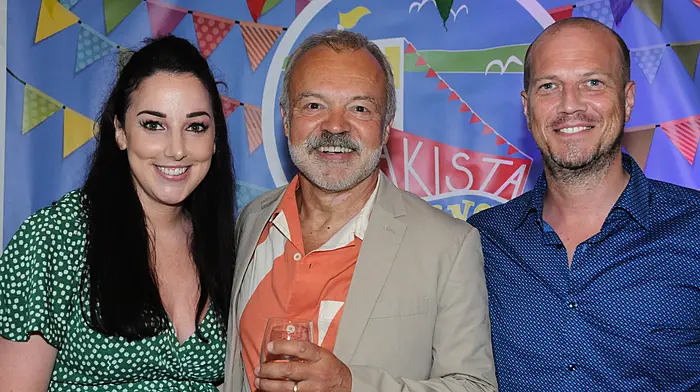LIKE many people, my favourite wildlife seasons are spring and summer due to the diversity of nature that flourishes. However, taking the sting out of the approach of winter is being able to head out for some birdwatching to spot some of the wonderful birds on their autumn migration.
The headlands and islands along the West Cork coast become bird spotting hotspots in September and October as our land becomes important for both arrivals and stop-offs. Most autumn migrating birds that arrive here have come from the north and the east. It is still unclear exactly how birds navigate and make these amazing journeys. It is thought that they are guided by the Earth’s magnetic field and navigate by the sun, the moon, and stars.
Ireland for the winter
While some of us may be dreaming of leaving Ireland for the winter, many bird species view our mild and wet winter climate as a prime destination. This is especially true for the wading birds, ducks, geese, and swans that flock to our coastline, estuaries, rivers, and lakes. These birds breed in northern countries in the spring and summer but when the harsh northerly winter conditions set in, they head south.
 The lapwing is an Irish resident bird, but numbers increase in winter when additional birds arrive from Scandinavia and Northern Europe. (Photos: Nick Haigh)
The lapwing is an Irish resident bird, but numbers increase in winter when additional birds arrive from Scandinavia and Northern Europe. (Photos: Nick Haigh)
Why migrate?
Fundamentally birds migrate to areas where resources such as food, water, and suitable habitat are more plentiful. In the spring, visitors from the south such as barn swallows, spotted flycatchers, and various warblers start to arrive from Africa. These birds fly north when it gets too hot and dry where they have spent the winter. Our spring and summer guests are mostly insect eaters that come for the summer surge of invertebrates that our climate provides. Many make use of our lush vegetation to nest securely.
Now that autumn has set in these birds are now leaving, or have already left, but different species begin to arrive to take their place. These new arrivals, usually from the north, include birds that feed on berries and seeds. Many others are waterbirds such as waders, geese, and ducks which migrate to escape freezing waters and avail of our year-round supply of aquatic invertebrates.
Just passing through
West Cork is also a great location for spotting passage migrants. These are birds that pass by and often stop off to rest and feed during their long journey north or south. We are in a fortunate position on the ‘East Atlantic Flyway’ and in the autumn we are treated to sightings of birds such as great skuas, sanderling, and curlew sandpiper as they pass by or stop off to refuel. Curlew sandpiper, as one of the examples, use our area as a rest stop as they fly from Siberia to Africa.
We even have some bird species, such as the blackcap, which almost make it seem like the birds are running a relay race. Blackcaps breed in Ireland in the spring and summer, but migrate south for the winter. However, blackcaps from north-east Europe migrate here to spend the winter, effectively taking the place of our breeding blackcap. It is truly amazing to think that the skies are crisscrossed by these various avian flight paths and that they are travelled annually by so many different bird species.
Boosting numbers
The population sizes of some of our resident birds increase during the autumn and winter due to additional birds of the same species migrating here. One example is the increase in starling numbers due to birds arriving from northern and north-eastern parts of Europe. In previous years there have been fantastic murmurations in Timoleague over the winter and these are well worth checking out if we are lucky enough to have them again this year. Murmurations are the shapes in the sky that massive flocks of starlings make at dusk, just before they descend to roost. Flock numbers can be huge, with tens of thousands congregating and flying in this mind-blowing synchronised way. Mistle thrush numbers also increase, with an influx coming from Northern Europe. Lapwings from Central and Western Europe also arrive to join our resident lapwing and become more noticeable in West Cork.
A little bit lost
Another reason to welcome the colder season is that your chances of spotting a rare vagrant bird increase. Vagrants are birds that turn up outside of their usual breeding and wintering range. Often, they are blown off course during migration and reach our shores due to Atlantic storms. Cape Clear and the Mizen are great birdwatching spots for these rare sightings as they are often the first land that birds encounter. Examples that set birdwatchers’ pulses racing are the yellow-rumped warbler, the isabelline wheatear, and the Baltimore oriole. The red-eyed vireo is an American bird which migrates from North to South America in the autumn but has been very occasionally spotted at the Mizen or on Cape Clear.
 One of a flock of over 200 migrant golden plover seen in a field in Toe Head in December last year. (Photo: Nick Haigh)
One of a flock of over 200 migrant golden plover seen in a field in Toe Head in December last year. (Photo: Nick Haigh)
Monitoring
Members of the public are encouraged to support the monitoring of birds by recording bird sightings online via the National Biodiversity Data Centre’s recording page. BirdWatch Ireland also run a garden bird monitoring survey between December and February each year and we are all encouraged to take part. Details are on their website. By participating in these schemes, information about all birds, including migrants, can be tracked, such as where and when they are being seen.
Migratory winter wading birds are separately monitored through the Irish Wetland Bird Survey which is funded by the National Parks and Wildlife Service (NPWS) and run by BirdWatch Ireland. Monitoring migratory birds reveals important trends such as increasing or decreasing numbers and can direct where conservation measures may be required.
In conclusion, while the warm weather has well and truly left us, the opportunities for wildlife spotting are far from over, especially when it comes to birds. I will be wrapping up in some warm layers and heading out in the hope of some interesting bird sightings and I hope you will be too!
Migratory Birds in West Cork
Some of the more common species of migratory birds in West Cork that are either arriving or departing at this time of year
Autumn arrivals
• Redwing
• Fieldfare
• Brambling
• Golden plover
• Bar-tailed godwit
• Greenshank
• Whooper swan
• Jack snipe
• Wigeon
• Common teal
Autumn departures
• Barn swallow
• House martin
• Sand martin
• Swift
• Spotted flycatcher
• Northern wheatear
• Willow warbler
• Sedge warbler
• Whitethroat
• Chiffchaff







